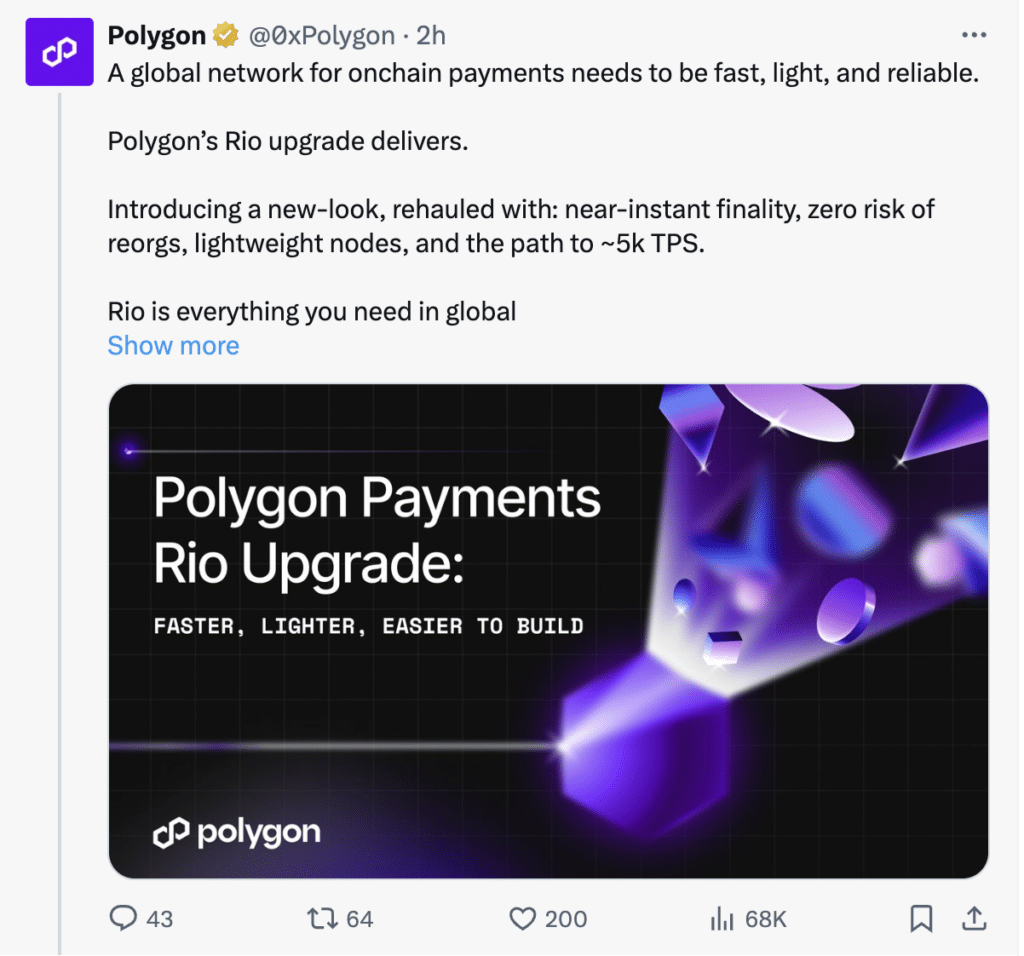Polygon’s Rio upgrade is a payments-focused overhaul that reduces reorgs, speeds settlement, and lowers node costs; it enables near-instant confirmations and targets ~5,000 TPS for Polygon PoS, positioning the chain for fintech and merchant payments adoption.
-
Rio reduces transaction rollbacks and accelerates finality for payments.
-
Validator selection is streamlined to improve throughput and lower hardware requirements.
-
Polygon PoS hopes to reach ~5,000 TPS; TVL and stablecoin flows remain lower than Solana and Base.
Polygon Rio upgrade: payments-focused overhaul boosting Polygon PoS speed and settlement. Read the impact and next steps for fintechs and merchants.
• • Author: COINOTAG
What is the Polygon Rio upgrade and why does it matter?
Polygon Rio upgrade is a payments-focused hardfork that redesigns block creation and validation to reduce reorgs, speed finality, and cut node costs. The change enables near-instant settlement, simpler node operation, and is intended to make Polygon PoS attractive to fintechs, payment processors, and stablecoin issuers.
How does Rio change block production and validator roles?
Rio replaces concurrent block proposals with a streamlined, elected block-proposer model. A smaller, selected set of validators handle block creation sequentially, which reduces overlaps and reorgs. This increases throughput, lowers confirmation times, and stabilizes transaction finality for payment flows.


Source: X
How will Rio affect operators, merchants, and payments integration?
Rio reduces node storage needs and lowers hardware minimums by removing the requirement for validators to store full chain history. This opens participation to smaller operators and lowers entry costs for payment providers. Fee-sharing adjustments also aim to distribute rewards more equitably among validators.
Polygon CEO Sandeep Nailwal said Rio “redesigns core architecture to make life easier for payments solution providers. By overhauling how blocks are created and verified, the upgrade sets the stage for Polygon PoS to reach around 5,000 transactions per second.”
Where does Polygon stand compared to competitors?
Polygon’s payments push arrives while Solana and Base lead on-chain activity and capital flows. Current ecosystem metrics (reported by DeFiLlama and network data) show Solana with a dominant TVL and Base with strong growth from retail on-ramps.
| Network | TVL (approx.) | Stablecoin Market Cap (approx.) |
|---|---|---|
| Solana | $12.53 billion | $15.31 billion |
| Base | $5.41 billion | $4.63 billion |
| Polygon PoS | $1.17 billion | $2.41 billion |
Despite lower TVL, Rio could help Polygon reclaim market share by prioritizing payments reliability and cost-efficiency. Polygon’s broader roadmap, including zkEVM developments, aims to combine Ethereum-derived security with high-throughput use cases.
What are the potential risks and limitations of Rio?
Rio optimizes for payments but requires ecosystem adoption from wallets, stablecoin issuers, and processors. Network security, decentralization trade-offs (fewer block proposers), and interoperability with Polygon’s zk and Layer-2 offerings are factors that will determine long-term success.
Frequently Asked Questions
Will Rio make Polygon transactions instant?
Rio significantly reduces finality times and reorgs, enabling near-instant confirmations for most payments. True instant settlement depends on integration choices made by wallets and payment rails.
Does Rio change validator requirements?
Yes. Rio lowers node storage and simplifies node operation by removing the need to store full history for every validator, reducing hardware costs for new participants.
Can merchants use Polygon for high-volume payments now?
Merchants can pilot on Polygon PoS post-Rio, but full-scale adoption depends on stablecoin integrations, payment processor support, and on-ramp liquidity.
Key Takeaways
- Payments focus: Rio redesigns block production to reduce reorgs and improve settlement finality.
- Lower barriers to entry: Node storage reductions make participation cheaper for smaller operators.
- Competitive outlook: Rio improves Polygon’s payments credentials but capital flows still lag Solana and Base.
Conclusion
The Polygon Rio upgrade refocuses Polygon PoS on payments by improving speed, reliability, and cost-efficiency. If fintechs, merchants, and stablecoin issuers adopt Rio-enabled flows, Polygon could meaningfully expand on-chain payments use cases. Watch for integration announcements and payment-rail pilots in the coming quarters.
